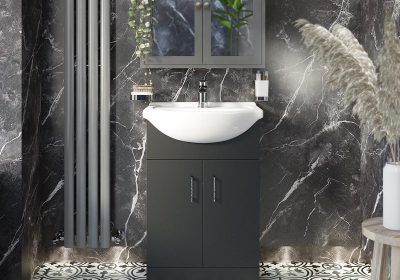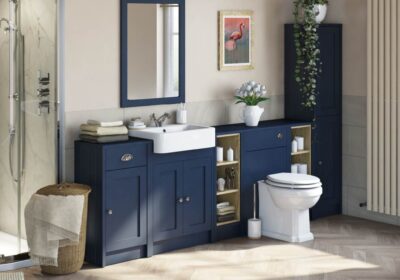Do you have a clogged toilet on your hands? There’s no need to call a plumber. We’ve got a simple yet effective trick that will help you unblock the toilet quickly and easily! All you need is a basic plunger and a few minutes of your time. We know that tackling an overflowing toilet is anyone’s worst nightmare, so let’s get to the bottom of this clog and get your bathroom back to normal. Read on to find out our simple plunger trick to unblock your toilet with ease.
Quick Insight
To unblock a toilet using a plunger, place the head of the plunger over the drain hole and push down firmly with your arm. Alternate between pushing in and releasing for at least one minute and then flush the toilet to see if the clog has been removed.
Unblocking Your Toilet with a Plunger
Unblocking a toilet with a plunger is one of the simplest and easiest methods for anyone to use. Plungers generate suction and apply pressure to the blockage, allowing it to be released quickly. This method is commonly used by plumbers, as it is cost-effective and straightforward. Additionally, due to its simplicity and effectiveness, many people choose to unclog their toilets at home by themselves using a plunger.
Nevertheless, there are a few common problems that can occur when unblocking a toilet with a plunger. For example, small pieces of waste or tissue may break off while unclogging and clog up other places of the drainage system. Furthermore, if there is too much pressure while pushing the plunger downwards, the rubber end can cause damage to the porcelain or ceramic walls of the toilet bowl. It’s important to take precautionary steps such as wrapping the rubber end in rags so as not to damage the bowl when using this technique to unclog your toilet.
It cannot be denied that plungers are an effective tool which has been used for decades in order to unblock toilets quickly and efficiently. However, it’s important for those attempting this method themselves to recognize potential risks and take appropriate cautionary steps in order to avoid further issues arising from unclogging a toilet with a plunger.
What is a Plunger?
A plunger, or also known as a plumber’s friend is arguably one of the most important tools in a handyman’s arsenal. As its name suggests, it is used for plumbing purposes to unclog sinks and toilets. It operates by relying on the power of suction to force water or air out of your pipes while simultaneously loosening and dislodging blockages. But there are some caveats – it needs to be used correctly, and this won’t always result in long-term success.
On the one hand, using a plunger does have an advantage. It is effective in removing minor blockages utilizing common household items such as toilet paper and feminine hygiene products as you will be able to create a vacuum seal that can loosen and break up light clogs quickly and efficiently. On the other hand, there are some cases where larger and more serious blockages will resist a plunger’s attempts to dislodge them and you may end up either damaging your pipes more or making the situation worse if done incorrectly. In this case, you will have no choice but to call a professional and hope for the best!
So when it comes to using a plunger to unblock your toilet, the decision is yours. However, if your situation persists after multiple attempts, remember that prevention is better than cure – invest in checking these problems before they surface so that you don’t end up with significant plumbing problems down the track! Once you’ve made that decision, learning how to properly wield your plunger will give you the confidence to tackle any challenged related to plumbing clogs!
- A study published in 2019 found that the most effective type of plunger for unblocking toilets is the bellows-style plunger.
- According to the American Society of Plumbing Engineers, using a plunger with an air release valve on the side can help increase suction and improve performance.
- The same study also found that plungers with flat rubber discs are more likely to succeed in dislodging blockages than traditional cup plungers.
Main Takeaways
The plunger is an essential tool for any handyman and can be used to unclog sinks and toilets. It operates by creating a vacuum seal to help break up lighter clogs, however it may not always be effective on larger clogs. To prevent plumbing problems from occurring, proper maintenance should be implemented. Lastly, learning how to use the plunger correctly will give you a better chance of unblocking pipes.
How to Use a Plunger?
Using a plunger is the most effective and quick way to unclog your toilet. By applying force, a plunger will help move solid particles and water down the drain. First, start by filling the toilet bowl halfway with water. This helps the suction of the plunger when you begin. When plunging, it is important to ensure that the end covers the entire opening of the drain. Move it up and down quickly to form an air tight seal. Push firmly and maintain pressure for up to 15 seconds before breaking it off and repeating this action several times until your toilet drains freely.
If there is an argument surrounding what type of plunger should be used, there are two sides. One side argues that using a cup-style plunger is better than a flange-style plunger because it offers more coverage over the drain hole which increases its suction strength when plunging. On the other hand, some claim that flange-style plungers are superior as they have more surface area for better contact with toilets than cup-style plungers. It’s often suggested that households keep both types handy in order to be prepared for any eventuality.
When it comes to evidence and examples, studies done by plumbing services found that the cup-style plunger was more successful than the flange-style plunger in removing clogs from toilets in the majority of cases they observed. However, further research needs to be conducted in order to make a concrete decision on this debate as various characteristics such as size discrepancies between different toilets could affect these results.
Although using a plunger is an easy solution, many people attempt other remedies first due to unfamiliarity or preferences for natural solutions. In the next section, we explore a natural option of cleaning and suction instead of relying solely on using a plunger when trying to clear blocked toilets.
A Natural Solution: Cleaning and Suction
Although plungers are often the go-to solution for clogged toilets, some people prefer natural solutions. Cleaning and suction can be done with items you probably have lying around the house.
First, it’s important to note that not all blockages are created equal. Many minor clogs can be cleared out using a plunger or commercial toilet cleaner. However, if you’re facing a major clog due to materials such as rocks or toys, eliminating the clog may require cleaning and suction techniques.
To start, don some gloves and grab a bucket of warm water mixed with natural cleaner like vinegar or baking soda. Pour the mixture into the bowl and allow it to sit for 5-10 minutes so it has time to break down whatever is causing the obstruction. Next, use an auger to reach into the bowl from beneath and physically pull out any remaining objects that are blocking the toilet. Finally, attach a wet-dry vacuum with a hose attachment and/or create a vacuum in the bowl using your plunger by forming an airtight seal and pushing up on one side of the toilet’s lip. Doing so will create suction and should help to loosen anything stuck in your pipes.
If all else fails, there are additional safe and effective solutions available. Before making any further attempts at resolving your issue, take a moment to transition to our next section, which will explore other methods of tackling stubborn and persistent clogs.
Using Cleanse and Water
Using cleanse and water is another way to unclog your toilet without the use of a plunger. This method typically involves adding a special solution or cleanser to the bowl for a set amount of time and then flushing with cold water. Some people swear by such solutions like Lysol’s Toilet Bowl Cleaner, which is able to break down debris clinging to the sides of the bowl. It’s important to note that while this can be effective for minor clogs, it can also increase the risk of damaging the seal within more complex clogs if it isn’t properly used.
On one hand, calls to professionals can be expensive and using this method leaves room for error but also offers the chance for some DIY success. On the other, opting for over-the-counter solutions might seem like an answer in the present, hiring a professional ensures that you will avoid future problems as well as provide peace of mind that you won’t have recurrent plumbing issues. Therefore, if you are experienced with DIY or plumbing projects, trying out a cleaner may work. If not, investing in a plumber expert may be more beneficial in the long run.
Ultimately, there is no single answer when it comes to unclogging toilets but understanding what options are available and what best suits your situation can help make reaching a resolution simpler. With many alternatives to consider such as plungers, snaking tools, and chemicals cleaners, approaches abound for tackling troublesome commodes. Consider all your options before taking action and seek advice from experts when necessary so you can easily move on from minor annoyances like a clogged toilet in no time.
Other Alternatives to Consider
While using cleanse and water is an efficient approach to unblock a toilet quickly, there are some other alternatives to consider as well. For those who might not have access to cleanse or any other form of chemical solutions, a baking soda and vinegar solution can be an effective substitution, as it has some of the same properties of a chemical cleaner and likewise creates an effervescent reaction. Moreover, the mixture will help soften blockages even if they have occurred due to hard deposits such as soap residue, grease, or limescale build up.
Additionally, one may consider using a drain snake or auger for more extreme cases of blockage. While this requires a bit more time and effort, it can be quite effective when used in moderation and offers greater control over the level of force that is applied to more stubborn blockages.
When you apply the right kind of pressure – either using cleanse and water, a baking soda and vinegar solution, or an auger – all will eventually lead to your toilet becoming unblocked. That said, it’s important to remember that going too far with any of these solutions can sometimes cause damage to your piping system. To minimize potential risk while reaping the most benefits possible, it might be wise to try pre-flushing before using any of these solutions.
Pre-Flush Before Using the Plunger
Now that we know a few alternative considerations to unclogging your toilet, let’s move on and discuss pre-flushing before using a plunger. Pre-flushing your toilet before you use the plunger is essential so that you can ensure the clog is accessible and can be easily managed by the plunger. If you plunge a clogged toilet without flushing first, it can cause more problems due to the water in the bowl not adequately soaking all the waste blocking the pipes. This makes plunging ineffective at dislodging stubborn blockages.
When arguing for the importance of pre-flushing before using a plunger, proponents argue that it helps reduce airborne blockage material from splashing out of the bowl due to vigorous plunging; as well as helping to capture any waste material that manages to escape during the process. Furthermore, with a wetter and shallower reservoir, there appears to be less strain on the user when attempting to make an effective seal between plunger cup and bowl lip with their hands and arms. Lastly, aquatic detergents may be used in combination with pre-flushing; providing additional cleaning power to dissolve some blockages prior to plunging.
On the other hand, critics claim that pre-flushing requires extra time and effort before you even begin to use the plunger, creating more delays in resolving your problem as quickly as possible. Additionally, those with older toilets may feel apprehensive about trying to create a good seal between plunger cup and bowl lip with their hands and arm which in turn could lead to potentially more vigorous plunging; thus risking splaying contaminated wastewater across one’s bathroom floor or walls.
In conclusion, despite critics’ disapproval of pre-flushing before using a plunger due to potential delays and risks involved; proponents argue for its efficacy in clearing blocked toilets due to reducing airborne blockage material from splashing out of the bowl during plunging, creating less strain on users when attempting to make an effective seal between plunger cup and bowl lip with their hands and arms; as well as providing cleaning power when certain chemical detergents are incorporated into one’s routine before plunging. Whether or not one decides to pre-flush before using a plunger ultimately comes down to personal preference.
Answers to Frequently Asked Questions with Detailed Explanations
Which types of plungers are best for unblocking a toilet?
The best type of plunge for unblocking a toilet is one with a foldable head, like an accordion-style plunger. These plungers provide better suction and can reach deeper into the drain to address tough clogs. They are also small enough to fit into tight spaces without damaging any surrounding surfaces. Additionally, the foldable head provides better control when manoeuvring, allowing you to apply more pressure within the pipe. This increased pressure is often necessary to push through tough clogs.
What is the correct technique for using a plunger to unblock a toilet?
The correct technique for using a plunger to unblock a toilet is called the “Plunger and Rock” method. To use this method, begin by covering the hole at the bottom of the plunger with water from the toilet bowl. Place the plunger over the opening of the blocked drain, making sure that it is firmly adhered to its surface. Move the plunger up and down vigorously for several seconds before pushing down hard on it, creating a seal around the drain. You should then rock the plunger back and forth in a rolling motion while maintaining pressure for several minutes until you feel resistance loosening. Finally, lift the plunger away from the drain and flush to rinse away any residual debris. This process should help to clear a blocked toilet effectively!
Are there any precautions to take before using a plunger to unblock a toilet?
Yes, there are several precautions to take before using a plunger to unblock a toilet. To begin with, make sure that the plunger size is appropriate for the size of the toilet drain, as an overly small plunger might be ineffective. Additionally, be sure to cover any nearby drain openings with a damp cloth or rag to ensure that the pressure generated from the plunger is concentrated on the blockage in the toilet drain. Finally, do not force the plunger into the drain – create a gentle seal instead and plunge firmly but carefully to avoid damage to the plumbing. With these simple precautions taken, unblocking your toilet with a plunger should be quick and easy.



